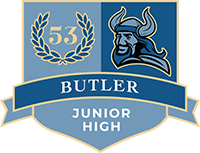Students learn the why, not just the what
Social studies may be difficult for some students to love. There’s the misconception that it’s all about memorizing dates, names and events.
Not so at Butler Junior High.
Sure, students learn about ancient Greece, medieval Europe, the Civil War and other times in history. But the focus is on studying the concepts and themes that reoccur throughout history and helping students learn how to apply those concepts to the ancient and modern world.
In short, students study and explore the “why,” not just the “what.”
“It is important that students grapple with big picture questions and develop connections between history and the world today,” said 8th grade social studies teacher Robert Philipp. In essence, this is critical thinking. And, it’s a large component of what experts say students need today in college and their careers.
Sixth grade social studies teacher John Hamilton visits with teams as they discuss and debate issues of ancient Greece.
When students explore, analyze, debate, synthesize and articulate different viewpoints, they are deepening their ability to evaluate conclusions and form original thought.
“It’s amazing to see the students develop as critical thinkers and see the wonderful connections and inferences they make every day,” said 7th grade social studies teacher Amanda Moore.
Every educator at Butler teaches students how to gather information, evaluate it and think for themselves. But in social studies, critical thinking skills are honed.
“Critical thinking is so important in our complex world. These skills apply to any situation in life that requires reflection, analysis, and planning,” said Principal Amy Read.
To practice this skill, John Hamilton’s 6th grade class studies ancient philosophies and applies them, of all things, to children’s books. For example, with Plato’s philosophy of metaphysics, students analyze it and compare it to the children’s book Harold and the Purple Crayon. “Plato’s idea is very complex and abstract but it becomes much easier to understand when we discuss it from the perspective of Harold and the Purple Crayon,” he said. Students then organize and lead a Socratic-like Seminar, which helps foster not only critical thinking but also public speaking.
The teachers work hard to make history relevant and come alive. Students take part in historical simulations, debates, re-enactments and history fairs.
For example, students’ in Philipp’s class create a model of the Chicago Columbian Exposition. In teams, student research and recreate one building while exploring the impact the fair had on architecture, city planning, sanitation and industry. All of the buildings are combined in the library to create one large model. Then groups present information about their buildings and answer important historical questions.
History comes alive in the classes through rich discussions, organized in a variety of formats. “The students love to debate,” said Moore. They conduct an organized debate called Philosophical Chairs, where students have to take a side, prove an historical issue and use supporting documents.
“The students have shown an amazing curiosity and passion for history,” she said.
